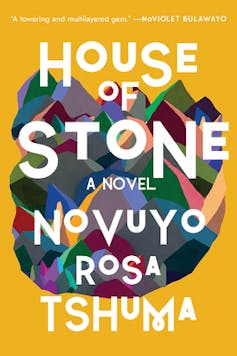A scene from a play about the Gukurahundi genocide, 1983 The Dark Years, performed in Harare in 2018.
JEKESAI NJIKIZANA/AFP/Getty Images
Gibson Ncube, University of Zimbabwe
“Let people vent,” lamented performing artist and television personality Kudzai Sevenzo in a tweet as Zimbabweans on social media reacted to the death of Perence Shiri. Shiri was the Minister of Lands, Agriculture and Rural Resettlement.
Zenzele Ndebele, an investigative journalist, also spoke out in a tweet: “Shiri gets to be buried like a hero. We never got a chance to mourn our relatives who were killed by the 5th Brigade.”
Shiri was a military man who commandeered a praetorian army that killed over 20,000 civilians in the provinces of Matabeleland and the Midlands between 1983 and 1987. Gukurahundi saw his North Korean-trained unit, the Fifth Brigade, descend on provinces inhabited by the Ndebele people to quell dissent. Gukurahundi is a Shona term referring to the early summer rains that remove chaff and dirt from the fields.
The death of Shiri on 29 July 2020 has kindled flames of debate that the ruling party has tried to shut down for many years.
I argue, in a paper on Gukurahundi, that writers and artists have left behind a richly textured memory on what writer Novuyo Rosa Tshuma has called the country’s “original sin”.
Enforced ‘collective amnesia’
In the aftermath of Gukurahundi, former president Robert Mugabe enforced collective forgetting of this period in Zimbabwe’s history. He referred to it simply as a “moment of madness” and suggested that discussing the events would undermine attempts to nurture national unity.
His successor, Emmerson Mnangagwa, Minister of State Security at the time of the Gukurahundi genocide, has also implored Zimbabweans to “let bygones be bygones”. At his 2017 inauguration he said that the past cannot be changed, but “there is a lot we can do in the present and the future to give our nation a different positive direction”.
However, as l contend in another paper, silence on Gukurahundi has not led to any national cohesion. Instead, it has been a part of what’s responsible for the culture of state violence and impunity in Zimbabwe since independence in 1980.
Writing against forgetting
Yet, a rich body of literary and visual artworks has emerged thematising the genocide. There have been books in indigenous languages such as Uyangisinda Lumhlaba (This world is unbearable) in Ndebele by Ezekiel Hleza and Mhandu Dzorusununguko (Enemies of independence) in Shona by Edward Masundire.
There has been an even bigger corpus of texts written in English. Among them is the late Yvonne Vera’s 2002 novel The Stone Virgins. It details the horrors faced by villagers from a ruthless army. In Running with Mother, a 2012 novel by Christopher Mlalazi, a child narrator, Rudo, recounts the arrival of the Fifth Brigade in her village.
Peter Godwin’s largely autobiographical Mukiwa: A White Boy in Africa
in 1996 gives a picture of Gukurahundi from the eyes of a young white journalist. And House of Stone, the 2018 novel by Novuyo Rosa Tshuma, tells the story of an orphaned young man trying to explore his past. He’ll find out that his father is Black Jesus (a name by which Shiri was known). Tshuma’s descriptions of the genocide are detailed, graphic and ghastly.
Literary creativity has made it possible to remember, commemorate and document experiences that otherwise would have been forgotten or dispersed through wilful omission. In doing so, literary texts create narratives of Zimbabwe’s history and national identity.
“To write is to banish silence,” writes Vera in her 1995 doctoral thesis on colonialism and narratives of resistance. “As a writer, you don’t want to suppress history, you want to be one of the people liberating stories.”
She explains that “to write is to engage possibilities for triumphant and repeated exits, inversion and recuperation of identity”. In this line of thinking, writing can offer victims of Gukurahundi a voice which the state continues to deny them.
Art of torture
Visual artworks have also engaged with Gukurahundi, such as in the exhibition Sibathontisele by Owen Maseko, which has stood for years as a material text-under-erasure in Zimbabwe. Sibathontisele is a Ndebele word meaning “we drip it on them”. It refers to an infamous torture technique used by the Fifth Brigade in which they dripped hot and melted plastic on victims.
Unlike literary texts, which have remained unbanned and uncensored, Maseko’s 2010 exhibition was banned by state security a day after its opening at the National Arts Gallery in Bulawayo and the artist was arrested. Visual art, it appears, is deemed more subversive than written texts. In spite of such restrictions, Maseko’s exhibition has been hosted outside Zimbabwe.
The artist explains in this article that art, justice and human rights are intricately interrelated. Visual art plays a role in bringing to the surface narratives on Gukurahundi, which have been buried for almost three decades.
The rich memory
Writers and visual artists are able to create alternative spaces for marginalised and forgotten stories. And Zimbabwe’s artists have created a rich memory and archive that counters the culture of forgetting and criminalising open discussion of Gukurahundi.
Through their works, histories are revisited so that they can be better understood and can be accorded their rightful recognition. They have opened new spaces of discussion and have gestured towards the importance of remembering and learning from the past.![]()
Gibson Ncube, Associate Professor, University of Zimbabwe
This article is republished from The Conversation under a Creative Commons license. Read the original article.
Post published in: Featured


